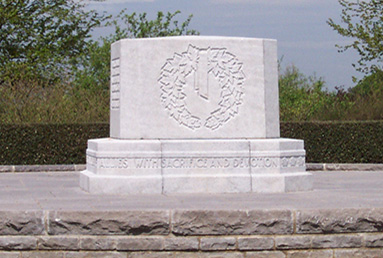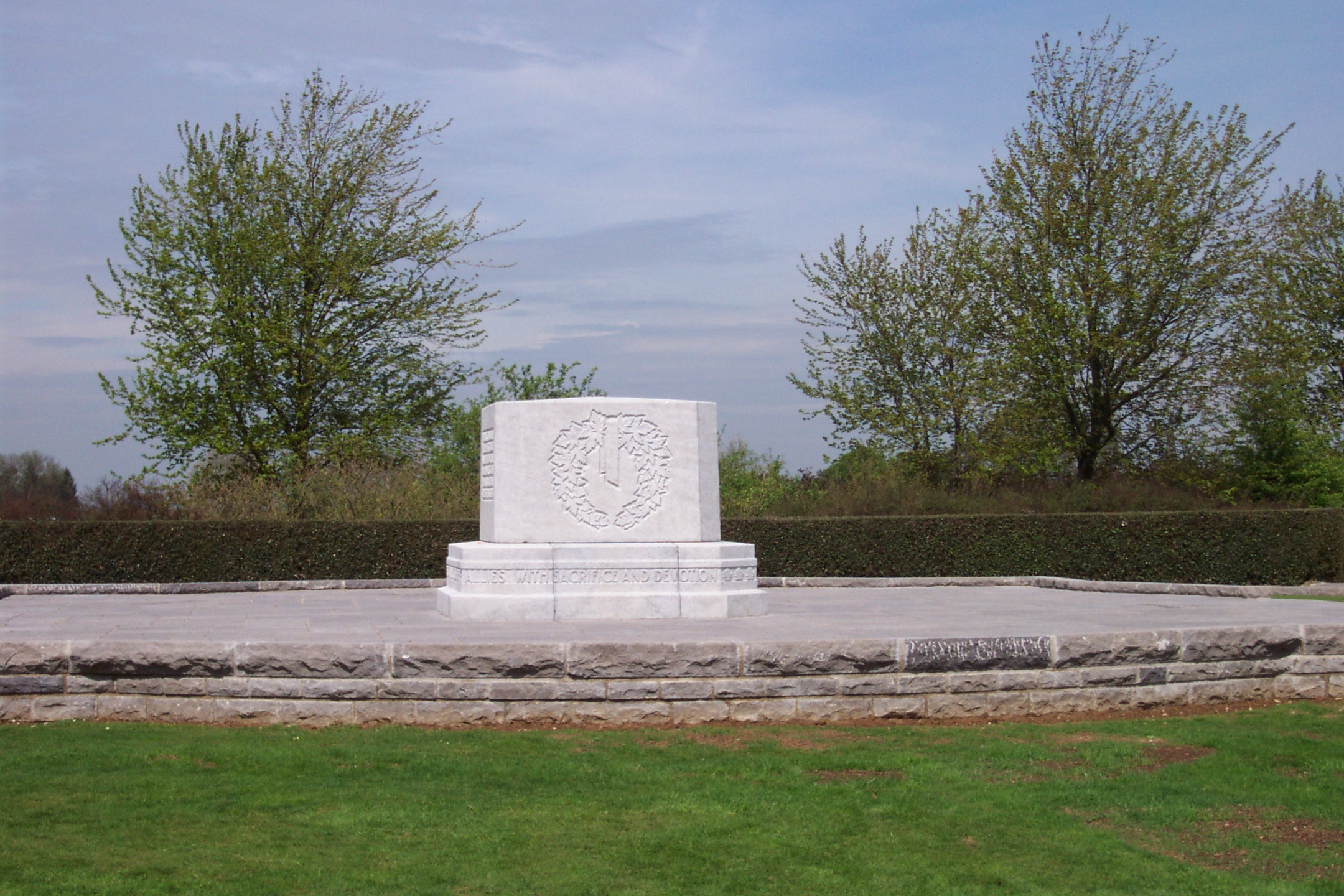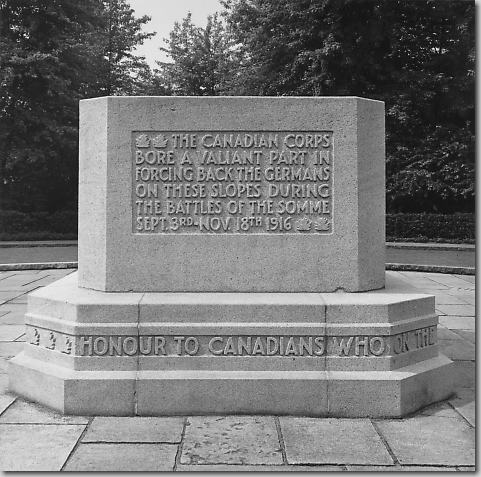On the granite block of the Courcelette Canadian Memorial is recorded the simple inscription:
THE CANADIAN CORPS BORE A VALIANT PART IN FORCING BACK THE GERMANS ON THESE SLOPES DURING THE BATTLES OF THE SOMME SEPT. 3RD - NOV. 18TH 1916
A circular park surrounds the memorial, screened from the road by tall trees. More than ten varieties of maples have been planted beside wide paths of well-tended turf. There are few bright colours to distract the eye from the pleasing shades of green, making the memorial park at Courcelette a place for meditation.
The Somme
When the Canadian Corps moved from the Ypres Salient to the Somme River region at the beginning of September 1916, its first major action was the Battle of Flers-Courcelette—a two-army assault launched by Sir Douglas Haig on September 15.
In the offensive that began at dawn, the Canadian Corps assaulted on a two-kilometre front near the village of Courcelette. Advancing behind a creeping barrage (a tactic only recently adopted by the artillery), the infantry was aided by the "new engine of war", the armoured tank, which frequently threw the enemy into complete confusion. The attack went well. By 8:00 a.m. the main objective, a defence bastion known as the Sugar Factory, was taken, and the Canadians pushed ahead to Courcelette. Numerous German counter-attacks were successfully repulsed and by the next day the position was consolidated. It is fitting, therefore, that the memorial to mark the 11 weeks of bloody fighting by Canadians on the battlefields of the Somme should be sited at the scene of their initial victory in that long and costly struggle.
In the weeks that followed, the three Canadian divisions again and again attacked a series of German entrenchments. The final Canadian objective was that "ditch of evil memory," Regina Trench. It repeatedly defied capture, and when the first three divisions were relieved in the middle of October, Regina Trench was closer, but still not taken.
When the newly arrived 4th Division took its place in the line, it faced an unbelievable ordeal of knee-deep mud and violent, murderous, enemy resistance. However, despite the almost impenetrable curtain of fire, on November 11, the Division captured Regina Trench only to find it reduced to a mere depression in the chalk.
A week later, in the final attack at the Somme, the Canadians advanced to Desire Trench - a remarkable feat of courage and endurance. The 4th Division then rejoined the Corps opposite Vimy Ridge.
There were no further advances that year. The autumn rains turned the battlefield into a bog and the offensive staggered to a halt. The line had been moved forward only ten kilometres; the Allies had suffered 600,000 casualties and 236,000 Germans were killed. The Germans refer to the Battle of the Somme as das Blutbad - the blood bath.
The Somme had cost Canada 24,029 casualties, but it was here that the Canadians confirmed their reputation as hard-hitting shock troops. "The Canadians," wrote Lloyd George, "played a part of such distinction that thenceforward they were marked out as storm troops. For the remainder of the war they were brought along to head the assault in one great battle after another. Whenever the Germans found the Canadian Corps coming into the line they prepared for the worst."
Directions
The Courcelette Canadian Memorial is about 30 kms northeast of Amiens, 35 kms south of Arras and 145 kms north of Paris. You can reach Amiens by train or by bus and from there take a taxi to the Memorial. The trip to the Memorial is approximately €75 return. You can also take the train as far as Albert and from there take a taxi; the trip to the Memorial is approximately €24 return. You can rent a bike at the train station, which costs approximately €5 per day, €11 per week and €17 per month.
Note: The cost of a taxi based on return trips without a waiting period. If you want the taxi to wait for you while you visit the site you will be charged €17.90 per hour. Bus connections are difficult and there are not many of them in the rural areas of the department of the Somme.
If you are travelling by car, please follow the directions below:
Note: Speed limits in France are 50 km/h in city limits and residential areas (generally unmarked), usually 90 km/h on secondary roads (but it may vary in areas) and 130 km/h on the motorway. Motorists should be aware of the priority from the right rule.
From Paris or Charles de Gaulle Airport take the A1 motorway, direction Lille. Continue on this road for approximately 135 kms and take exit 14 for Bapaume; when in Bapaume follow directions for Albert D929. The monument is on the Bapaume/Albert road, on your right just beyond the turn off to Courcelette. It should take you approximately 1 1/4 to 1½ hours to reach the Memorial.
From Amiens take the D929 direction, Bapaume. Continue on this road for approximately 30 kms. The monument is on the Bapaume/Albert road, on your left, about 2 kms beyond the village of Pozières. It should take you approximately 40 minutes to reach the Memorial.
From Arras take the A1 motorway, direction Paris. Continue on this road for approximately 25 kms. Take exit 14 for Bapaume; when in Bapaume follow directions for Albert D929. The monument is on the Bapaume/Albert road, on your right, just beyond the turn off to Courcelette. It should take you approximately 40 minutes to reach the Memorial.
From Calais take the A26 and continue on this road for approximately 130 kms. Turn south on the A1 towards Paris and drive for about 25 kms. Take exit 14 for Bapaume; when in Bapaume follow directions for Albert D929. The monument is on the Bapaume/Albert road, on your right, just beyond the turn off to Courcelette. It should take you approximately 1½ to 2 hours to reach the Memorial.
From Lille take the A1, direction Paris. Continue on this road for approximately 70 kms. Take exit 14 for Bapaume; when in Bapaume follow directions for Albert D929. The monument is on the Bapaume/Albert road, on your right, just beyond the turn off to Courcelette. It should take you approximately 1 hour to reach the Memorial.


